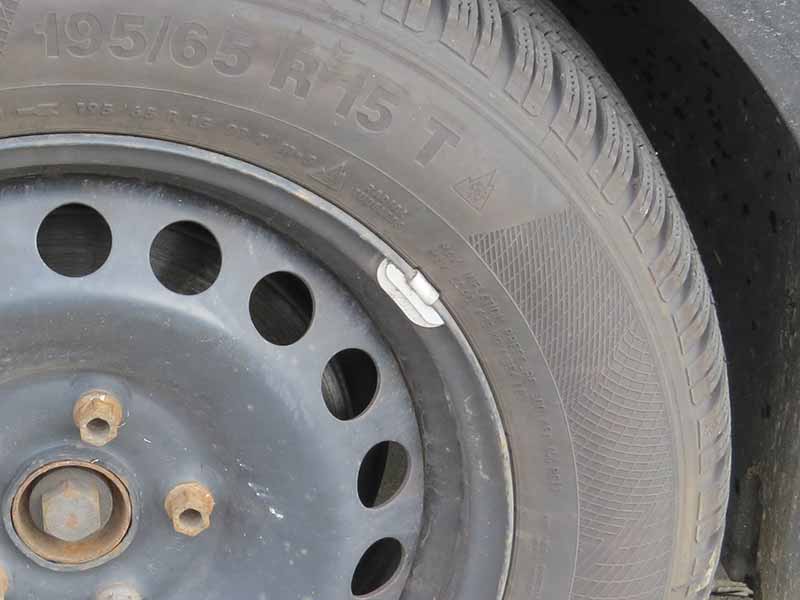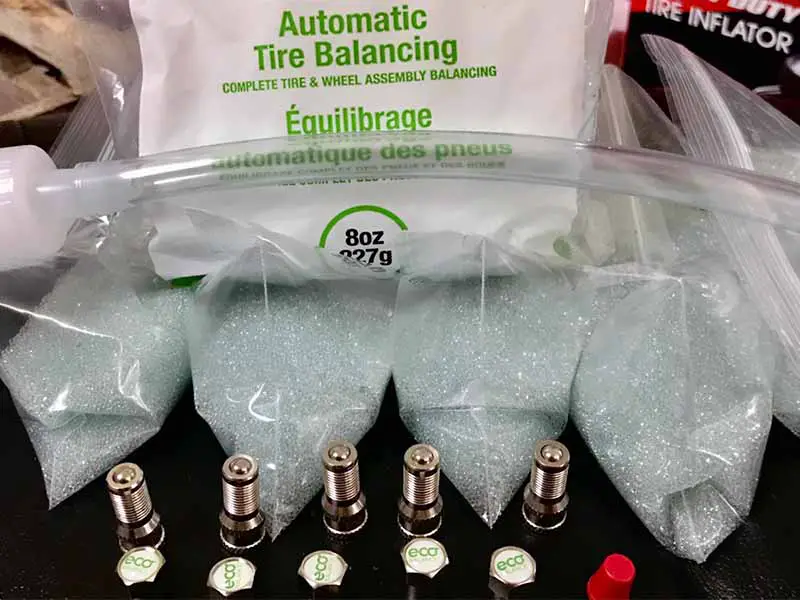Switching to a new method for anything can be daunting, especially when it comes to having your tires balanced. You’ve probably caught wind of balancing beads as the next big thing in tire maintenance.
Curious? Skeptical? Let’s journey together into the heart of this innovation to see if it’s truly the game-changer many claim it to be.
How Do Balancing Beads Work?
Balancing beads are tiny compounds placed inside tires, working dynamically to counteract imbalances as they develop. They adjust in real-time, offering a continuous balance in contrast to traditional fixed weights.
In this article, we will dive deep into the mechanics of balancing beads, explore their benefits and concerns, and compare them to traditional weights, equipping you with all the knowledge you need on this innovative tire balancing solution.
Let’s take a closer look.

Counteract Balance Beads
How Do Balancing Beads Work?
While it’s established that balancing beads are a unique solution to tire imbalances, understanding the mechanics behind their operation is crucial. Let’s dive deep into the action and effectiveness of these small yet mighty tools.
The Science Behind the Beads
At the core, the operation of balancing beads is based on simple principles of physics. Here’s how they work:
- Dynamic Equilibrium: When the tire rotates, beads move freely within, seeking areas of imbalance due to centrifugal forces. This constant movement ensures they always address the tire’s current need for balance.
- Gravity’s Role: As beads shift towards imbalanced areas, gravity aids in keeping them in place, countering the imbalance until the tire stops. When the tire starts moving again, the beads reassess and adjust.
Response Time: When Do Beads Kick in?
One common question is: How long does it take for balancing beads to work? Let’s clarify:
- Immediate Action: As soon as the tire begins to rotate, the beads start moving. Typically, by the time you reach common city driving speeds, they’ve already distributed themselves to balance the tire.
- Consistent Work: As conditions change – say, from city streets to highways – the beads continue to adjust in real-time, ensuring the tire remains balanced.
Factors Influencing Bead Performance
The effectiveness of balancing beads can be influenced by several factors:
- Tire Size and Shape: Larger tires, like those on trucks, might require more beads for effective balancing compared to smaller passenger car tires.
- Bead Material: While most beads are made of durable materials like ceramic, the specific composition can impact their performance.
- Driving Conditions: Rough terrains or frequent stopping and starting (as in city driving) can affect how the beads distribute themselves.
Balancing Beads vs Traditional Weights
While traditional weights offer a static solution, balancing beads provide a dynamic approach:
- Adaptability: Traditional weights remain fixed. If a new imbalance develops, the weights can’t address it. Balancing beads, on the other hand, adjust continuously.
- Longevity: Over time, as tires wear, the nature of their imbalance can change. Balancing beads can cater to these changes throughout the tire’s lifespan, whereas weights might become less effective.

Benefits of Using Balancing Beads
When it comes to modern tire balancing solutions, balancing beads have made a noteworthy impact. While every innovation has its share of skeptics, understanding the benefits of these beads can shed light on why they’ve become a preferred choice for many. Here’s a detailed look into the advantages they offer.
Dynamic Real-time Balancing
- Continuous Adjustment: As tires wear down or face various terrains, imbalances can emerge or shift. Balancing beads constantly adjust to these changes, ensuring a consistent balance.
- Immediate Response: The beads begin their balancing act as soon as the vehicle starts moving, rapidly distributing themselves to counteract any imbalances.
Improved Tire Lifespan
- Uniform Wear: By consistently maintaining tire balance, these beads promote even tread wear, which can extend the tire’s lifespan.
- Prevention of Hot Spots: Imbalanced tires can develop areas of excessive heat due to uneven contact with the road. Balancing beads help in preventing this, further ensuring a longer tire life.
Cost-Effectiveness
- Reduced Maintenance: Traditional weights might require readjustments or replacements more often, especially if they become dislodged. The continuous action of balancing beads can mean fewer trips to the mechanic for tire-related issues.
- Fuel Efficiency: A balanced tire ensures optimal contact with the road, reducing drag and potentially improving fuel consumption.
Aesthetic and Practical Benefits
- Invisibility: For drivers who are particular about the appearance of their wheels, balancing beads offer an aesthetic advantage, being hidden from view inside the tire.
- Universal Application: Whether it’s a passenger car or a heavy-duty truck, balancing beads can be applied across various vehicle types.
High-Speed Performance
Addressing a common query: Do balance beads work at high speeds?
- Consistent Balance: Balancing beads are designed to work effectively across a range of speeds. As the speed increases, the centrifugal force ensures the beads are effectively distributed, maintaining the balance even at high speeds.
Longevity and Reusability
Touching on another frequently asked question: How long do balance beads last?
- Durable Materials: Typically made of hard-wearing compounds like ceramic, tire beads are designed to last as long as the tire itself.
- Reusability: Once a tire reaches the end of its life, the beads can often be collected and reused in another tire, adding to their cost-effectiveness.

Potential Issues with Tire Balancing Beads
While tire balancing beads offer a modern approach to achieving balanced tires, they are not without their potential issues. It’s crucial for drivers to be aware of these concerns to make informed decisions:
- Noise Production: Some drivers have reported hearing a swishing or rolling sound, especially at lower speeds. This noise can result from the movement of the beads within the tire.
- Possible Ineffectiveness: In situations with severe tire imbalances, balancing beads may not provide a complete solution. Traditional balancing methods might be required in tandem for optimal results.
- Installation Concerns:
- TPMS Issues: There are concerns that beads can interfere or even damage the Tire Pressure Monitoring System (TPMS) sensors, especially if not used as per recommendations.
- Clumping: In humid conditions or due to the use of tire sealants, beads may clump together, reducing their effectiveness.
- Longevity Doubts: While manufacturers claim that balancing beads can last the lifetime of a tire, external factors like moisture can affect their lifespan.
- High-Speed Performance: While many users find balancing beads effective at regular speeds, concerns arise regarding their efficiency at very high speeds. It’s essential to consult a tire professional for specific applications.
How Many Balancing Beads to Use
Ensuring the right quantity of balance beads in your tires is crucial for optimal performance. Using an incorrect amount can lead to various issues. Let’s delve into how to determine the correct amount and the repercussions of not adhering to these guidelines.
Determining the Right Quantity
- Manufacturer’s Guidelines: Always refer to the manufacturer’s recommendations for the specific type and size of tire you’re using. They usually provide a chart or guidelines based on tire dimensions.
- Tire Size and Type: The quantity of tire beads needed typically correlates with the tire’s volume. Larger tires, like those for trucks or tractors, will require more beads than passenger car tires.
- Available Kits: Many manufacturers offer kits that are pre-measured for different tire sizes, simplifying the process for users.
Consequences of Using Too Many Balancing Beads
- Noise and Vibration: Overloading a tire with beads can create unusual noises or vibrations, as the beads may not have enough space to distribute and function optimally.
- Interference with TPMS: An excess of beads might increase the chances of them interfering with the Tire Pressure Monitoring System, potentially leading to false readings or sensor damage.
- Reduced Effectiveness: Ironically, too many beads can reduce their balancing efficiency. Instead of counteracting imbalances, they might exacerbate them.
Consequences of Using Too Few Balancing Beads
- Inadequate Balancing: The primary issue with using too few beads is that they might not effectively counteract the imbalances in the tire, leading to vibrations and uneven wear.
- Increased Tire Wear: Insufficient bead quantity can result in uneven tire wear, reducing its lifespan and compromising safety.
- Potential for Clumping: A smaller number of beads might have a higher tendency to clump together, especially if moisture or sealants are present inside the tire.

Tire Balance Beads Vs Wheel Weights
Tire balancing is essential for a smooth ride, and the market presents two popular solutions: tire balancing beads and traditional wheel weights. Let’s dissect their differences, strengths, and drawbacks.
Mechanism of Action
- Tire Balancing Beads:
- Dynamically balance the tire by distributing themselves based on the imbalance present.
- Constantly adjust as the tire wears down, ensuring continuous balance.
- Wheel Weights:
- Static weights affixed to the wheel’s rim.
- Address imbalances at specific points but don’t adjust as the tire wears or as imbalances change.
Installation and Visibility
- Tire Balancing Beads:
- Inserted inside the tire, rendering them invisible from the outside.
- No risk of being thrown off the tire due to external impacts.
- Wheel Weights:
- Clamped to the outer or inner rim of the wheel.
- Visible, which can affect the aesthetic appeal of the wheel.
- Can potentially become dislodged over time or due to impact.
Longevity and Maintenance
- Tire Balancing Beads:
- Designed to last the life of the tire.
- Can be reused in new tires.
- Require minimal maintenance.
- Wheel Weights:
- Might need periodic adjustments or replacements.
- Can corrode or deteriorate over time.
Environmental Considerations
- Tire Balancing Beads:
- Typically made from ceramic or other environmentally neutral materials.
- Reusability reduces wastage.
- Wheel Weights:
- Traditional lead weights have environmental concerns, but many places have switched to steel or other less harmful materials.
Cost Implications
- Tire Balancing Beads:
- Might be pricier initially but can be cost-effective in the long run due to reduced maintenance needs and reusability.
- Wheel Weights:
- Typically cheaper initially.
- Potential costs in the long run due to replacement and maintenance.
Performance and Limitations
- Tire Balancing Beads:
- Effective across various speeds.
- Some concerns about noise and potential ineffectiveness in extreme imbalances.
- Wheel Weights:
- Proven and reliable performance.
- Don’t adjust dynamically to new imbalances as tires wear.

Understanding Tire Imbalances
Tire imbalances can be a sneaky culprit behind a myriad of driving issues. For the average driver, understanding these imbalances can save both time and money. Let’s delve into the causes, types, and effects of tire imbalances.
Causes of Tire Imbalances
Tires, despite looking symmetrical and even, can possess irregular weight distributions. These can be due to:
- Manufacturing variances: No two tires are perfectly alike. Tiny differences in the manufacturing process can result in weight disparities.
- Tread wear: As tires roll, they don’t wear evenly all the time. Various driving conditions, like frequent stops, sharp turns, or potholes, can lead to uneven tread wear.
- External damages: Punctures, embedded stones, or other damages can change a tire’s weight distribution.
Types of Imbalances
Tire imbalances generally fall into two main categories:
- Static Imbalance:
- This occurs when there’s a heavy or light spot in the tire that causes it to hop or wobble as it rolls.
- It’s like having a washing machine that’s off-balance; the whole machine shakes.
- Dynamic Imbalance:
- Here, there’s an imbalance on both the inside and outside of the tire.
- Imagine a see-saw with unequal weight on both ends; it won’t stay level.
Effects of Tire Imbalances
When tires are imbalanced, they can cause various problems, including:
- Decreased Fuel Efficiency: Imbalanced tires can make your vehicle work harder, consuming more fuel.
- Uneven Tire Wear: The imbalanced portion will wear out faster, reducing the lifespan of the tire.
- Vibration Issues: You might feel vibrations in the steering wheel, seat, or floorboard. It’s especially noticeable at higher speeds.
- Strain on Vehicle Components: Imbalanced tires can put extra stress on parts like bearings, shocks, and other suspension components.
- Reduced Driving Comfort: Aside from vibrations, imbalanced tires can also lead to a bumpier and less comfortable ride.
Resources
Below are some links you may find helpful when learning about tires
- Ask the expert: Why shouldn’t Counteract balancing beads be used in automotive applications? – Vehicle Service Pros
- Tire balancing beads and automatic tire balancers what are they used for? – Mortons On The Move
Final Thoughts
In our of using tire beads to have your tires balanced, we’ve seen that they present a compelling alternative to traditional weights. Tire beads dynamically adjust to tire imbalances, offer aesthetic discretion by being inside the tire, and can even extend the tire’s lifespan by promoting even wear.
However, like all innovations, they come with their set of considerations, from potential noise issues to ensuring correct installation. Whether choosing beads, weights, or a combination of both, it’s crucial to understand their nuances and benefits.
Good luck and happy motoring.






